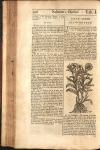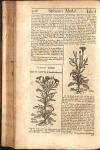

 I. The Names. It is called in Greek, ****; à floris Cyaneo, vel Coeruleo colore: In Latin, Cyanus: and in English, Blew-bottle, or Cornflower.
I. The Names. It is called in Greek, ****; à floris Cyaneo, vel Coeruleo colore: In Latin, Cyanus: and in English, Blew-bottle, or Cornflower.
II. The Kinds. It is twofold:
- 1. Single-flowred, of which in this Chapter.
- 2. Double-flowred, of which in the next.
The single flowred is also
- 1. Cyanus magnus, vel Cyanus major vulgaris, Cyanus hortensis, The greater Common Blew-bottle, or Garden Blew-bottle. This some call Cyanus montanus; Hermolaus takes it to be the Leucoium Dioscoridis; Caesalpinus to be a kind of Struthium Theophrasti: Fabius Columna, thinks it to be Papaver Heracleum Theophrasti; and Lobel questions whether it be not a Species of Chondrilla. (Centaurea montana. -Henriette.)
- 2. Cyanus minor vulgaris, Cyanus segetum, The lesser Common Blew, or Field Blew-bottle: It is called by some flos Frumenti, Corn-flower: Battisecula (as Ray has it) and Baptisecula, or Blaptisecula, from its turning the Edges of Sickles in cutting down Corn; Secula, i. e. Falx, à fecundo dicta, being taken for a Sickle in Ancient times. (Centaurea cyanus. -Henriette.)
III. The Description. The Greater or Garden Blew-bottle has a Root which creeps under ground, spreading it self divers ways, so that its heads with green Leaves will abide all the Winter, (which in the other sorts do not so, but perish wholly after Seed time, rising again of their own Sowing before Winter) and grows Yearly into new shoots and springs, by which it very much increases: from this Root rises up a crested or rather winged Stalk, of a whitish green color, about two or three feet high, on which are set divers Leaves, something long and broad, without any division, or denting in about the edges; green on the upper side, and grayish underneath, each of of them encompassing the Stalk about, at the lower ends, which is divided at the top into a few Branches, bearing somewhat large, scaly, green heads, with white or Silver-like edges; from the midst of which comes forth a larger flower than in the smaller Kind, thinly set, and of a deeper Violet-blew color: in which Heads, after the flowers are past, there is found a Down, containing some few white Seeds, like those of the lesser Kind, but a little larger, and flatter.
 IV. The lesser Common, or Field Blew-bottle, or Corn-flower, has Roots somewhat long and large, which Perish every Year, but are Annually renewed by its own sowing; rising or springing up before Winter, and abiding green all the Winter Season, until the next Spring and Summer, when it flowers, Seeds, and perishes again. The Leaves are long and narrower than the former, of a whitish green color, deeply cut in on the Edges in some places, but some more than others, something like unto Scabious leaves. The Stalks are two or three feet high, according to the goodness and fertility of the Ground, set with such like Leaves, but smaller, and little or nothing cut in on the Edges: the tops are spread forth into Several Branches, bearing many small green, scaly Heads, out of which rise flowers, consisting of five or six, or more, long and hollow Leaves, small at the bottom, and opening wider and larger at the brims, notched, dented or cut in on the Edges, and standing round about many small threads in the middle. The colors of these flowers are manifold, and very variable; for some are wholly Blew, or White, or blush, or of a sad or light Purple, or of a light or deep Red or of an over-worn Purple color, or else mixed of these colors, in some, the edges White, and the rest Blue or Purple; or the edges Blew or Purple and the rest of the flower White, or Striped, Spotted or halved, the one part of one color, the other of another, and the Threads also in the middle varying in many of them; for in some the said middle Thread will be of a deeper Purple than the outward Leaves, some will have it Reddish, deeper, or paler, whilst the Leaves are White, or blush. The flowers being past the heads, or bottles contain a Down, in which the Seed is wrapped, which is small, hard, white and shining. Note, That the flower of that which grows Wild in the fields, is for the most part only Blew.
IV. The lesser Common, or Field Blew-bottle, or Corn-flower, has Roots somewhat long and large, which Perish every Year, but are Annually renewed by its own sowing; rising or springing up before Winter, and abiding green all the Winter Season, until the next Spring and Summer, when it flowers, Seeds, and perishes again. The Leaves are long and narrower than the former, of a whitish green color, deeply cut in on the Edges in some places, but some more than others, something like unto Scabious leaves. The Stalks are two or three feet high, according to the goodness and fertility of the Ground, set with such like Leaves, but smaller, and little or nothing cut in on the Edges: the tops are spread forth into Several Branches, bearing many small green, scaly Heads, out of which rise flowers, consisting of five or six, or more, long and hollow Leaves, small at the bottom, and opening wider and larger at the brims, notched, dented or cut in on the Edges, and standing round about many small threads in the middle. The colors of these flowers are manifold, and very variable; for some are wholly Blew, or White, or blush, or of a sad or light Purple, or of a light or deep Red or of an over-worn Purple color, or else mixed of these colors, in some, the edges White, and the rest Blue or Purple; or the edges Blew or Purple and the rest of the flower White, or Striped, Spotted or halved, the one part of one color, the other of another, and the Threads also in the middle varying in many of them; for in some the said middle Thread will be of a deeper Purple than the outward Leaves, some will have it Reddish, deeper, or paler, whilst the Leaves are White, or blush. The flowers being past the heads, or bottles contain a Down, in which the Seed is wrapped, which is small, hard, white and shining. Note, That the flower of that which grows Wild in the fields, is for the most part only Blew.
V. The Places. The first grows Wild in Germany upon Sandy Hills, but with us it is nourished up in Gardens: The other With Blew Flowers grows Wild, in many Corn Fields throughout our Kingdom: It is found in Fields of Wheat, Rye and Barley; but is also Sown in Gardens, which the skilful Artist, by looking after, makes to become of other colors, as in the description thereof is declared.
VI. The Times. They flower from the beginning of May, to the end of Harvest, and their Seed comes to ripeness in the mean season.
VII. The Qualities. They are temperate in respect to heat or cold, and dry in the first Degree: But Schroder says, they are cold and dry in the second Degree: They are astringent, Ophthalmick, Cardiack, Alterative, and Alexipharmick.
VIII. The Specification. They have a peculiar faculty for the curing of sore and bleared Eyes, and resisting the force of Poison.
IX. The Preparations. In the Shops are:
- 1. The Flowers.
- 2. A Pouder of the dried Leaves.
- 3. An Essence of the Juice with Spirit of Wine.
- 4. A Collyrium of the flowers.
- 5. A Distilled Water of the Flowers.
- 6. A Spirituous Tincture of the Flowers.
- 7. A Cataplasm of the Flowers.
- 8. A Juice
- 9. A Distilled Water of the Herb.
The Virtues.
X. The flowers. They are cold and dry in 1 degree: are Styptick, and good to takeaway Redness and Inflammations of the Eyes, and pains thereof: they cool in Fevers, resist Poison, and help in Dropsies. You may make an Acid Tincture of them with Spirit of Wine, mixed with a half part of Spirit of Salt, which in Fevers, Plague, &c. may be given from 20 to 40 Drops, in any fit Vehicle.
XI. The Pouder of the dried Leaves. It is taken in Tent to one dram, for the curing of inward bruises, and to heal a Rupture of the Veins, &c. whereby they void much Blood at Mouth. Give it in Plantane, Comfrey, or Horse-tail water, acuated with a little White Wine Vinegar.
XII. The Essence of the Juice of the Leaves and flowers. It has all the former Virtues both of the Acid Tincture and Pouder: It helps in the Dropsie, resists all manner of Venoms and Poisons, and is peculiar against that of the Scorpion, Phalangium, Viper, Mad-Dog, and Plague, as also all other Pestilential Fevers, and Infectious Diseases: being dropt into the Eyes, it takes away their heat, inflammation and pain.
XIII. The Collyrium, or Eye-Water, Rx of the Blew-flowers as many as you please: put them into Rye Dough or Paste, bake them in the Oven with house hold Bread, then taking it forth, distil all, viz. Flowers and Rye Paste, in a Glass Body, in B.M. and keep the Water for use. With this the Eyes are to be washt three or four times a day. It is admirable for the cure of most Infirmities of the Eyes, especially Heat, Inflammation, Pain, Blood-shot, &c. It clears, strengthens and preserves the Eye-sight especially of old People, for which reason some are pleased to call it Break-Spectacle-Water: for that those that use it, need never come to the use of Spectacles: If the Distemper is inveterate or stubborn, use it five or six times a day.
XIV. The Distilled Water of the flowers. Aqua florum Cyani, Blew-bottle-flower-water. Rx flowers of blew-bottles, with their Cups, as many as you please: bruise them, and macerate them in a sufficient quantity of Snow-water, for 24 Hours, or rather two Days then Distill in a gentle B.M. or Sand heat. It is said to be a wonderful Water for the Eyes, and their Diseases, as Inflammations, Soreness, Dimness of Sight, and the like: it has the Virtues of the former, but not altogether so powerful. Drop it into the Eyes 3, 4, 5 or 6 times a day.
 XV. The Spirituous Tincture of the Flowers. Made with Common Brandy, it is a secret for curing Sore and Running Eyes, if some few times dropt into them. It is Alexipharmick, and has all the Virtues of the Essence. Dose half a Spoonful in any proper Vehicle.
XV. The Spirituous Tincture of the Flowers. Made with Common Brandy, it is a secret for curing Sore and Running Eyes, if some few times dropt into them. It is Alexipharmick, and has all the Virtues of the Essence. Dose half a Spoonful in any proper Vehicle.
XVI. The Cataplasm of the Flowers. Being applied to Sore and Running Eyes, afflicted with a hot Rheum, it strengthens the Part, cools the Inflammation, represses the flux of Humors, and heals the Eyes.
XVII. The Liquid Juice. It is very effectual to heal all Sores and Ulcers of the Mouth; and put into fresh or green Wounds, it conglutinates their Lips, and quickly heals them; And dropt into the Eyes, it, takes away their Heat, Inflammation, and Pain.
XVIII. The Distilled Water of the Herb. It has the same properties with the Juice, and Essence, but not altogether so powerful.
Botanologia, or The English Herbal, was written by William Salmon, M.D., in 1710.
This chapter has been proofread by Nick Jones.

